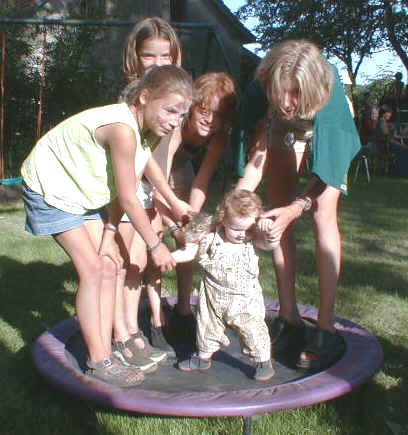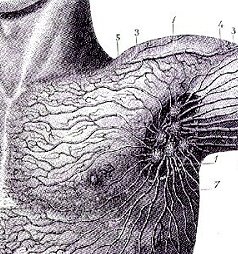pH Pocket Chart?
Alkalize, energize, detoxify,
FEEL BETTER- drink
high pH alkaline water
and use frequency healing
from the
for optimal wellness
and anti-aging!
More Rebounding Health Benefits
Bouncing on a mini-trampoline may not be your idea of a strenuous aerobic exercise and it may not strike you as having significant health benefits, but, in fact, both are the case. Rebounding, as this form of safe, gentle, no-impact exercise is commonly called, burns more calories than jogging. Trampoline bouncing also can strengthen your heart, improve your circulation, stimulate the flow in your lymphatic system, help slow the effects of aging, revitalize vision, reduce stress, and benefit children with learning disabilities and cystic fibrosis. Tony Robbins, the popular motivational speaker, endorses the exercise of rebounding in addition to his highly acclaimed life-changing programs.
Rebounding offers an exercise that can be adjusted to your fitness level, is easy on your joints and back, and can be done in your home at your convenience. The rebounding device is a mini-trampoline with a flexible jumping surface measuring 28 to 36 inches in diameter and set six to nine inches off the ground.
Rebounding may be used in conjunction with niacin and ionized water to help detoxify fatty tissues.
The jumping mat is attached to the frame with a series of coil springs, providing a good rebound while remaining firm on the downward bounce. Unlike a regular trampoline, the rebounding device is not meant for bouncing high or performing gymnastic tricks.
Rebounding is a unique exercise in that you achieve a weightless state at the top of each jump then land with twice the force of gravity on each bounce. This twice-gravity bounce affects every muscle and cell of the body. Researchers at the University of Kentucky, in conjunction with NASA, concluded that "the magnitude of the biomechanical stimuli is greater with jumping on a trampoline than with running."
For example, a 150-pound person spending one hour on a rebounder will burn about 410 calories; the same person jogging for one hour (at the pace of five miles per hour) will burn only 355 calories.
They further reported, based on their testing of physiological responses in eight men, age 19 to 26: "These responses measured by whole-body vibration [on the trampoline] resemble those during mild exercise and suggest that perhaps body vibration could be used in place of exercise."
All May Benefit From Rebounding Exercise
According to the Healthy Cell News, other rebounding benefits include decreasing headaches (both frequency and strength), reducing back and joint pains, alleviating arthritic symptoms, such as pain and inflammation, and boosting energy levels. Because the exercise provided by rebounding is sufficiently gentle, both the elderly and the pregnant can safely participate; in addition, it is suitable for those who are physically handicapped and those recovering from an accident or injury or who are otherwise hampered by a physical problem.
Rebounding Helps Move the Lymph
One of rebounding's special benefits is its ability toimprove flow in the lymphatic system. The lymphatic system is the metabolic garbage can of the body. It rids the body of toxins, fatigue substances, dead cells, cancer cells, nitrogenous wastes, trapped protein, fatty globules, pathogenic bacteria, infectious viruses, foreign substances, heavy metals, and other assorted junk the cells cast off.
Stagnant or inadequate lymph flow is associated with the onset of many symptoms and illnesses, including bursitis in the shoulders, bunions, joint stiffness or soft tissue spasms, dry flaking skin, bad breath, body odors, lethargy, depression, and cancer. Unlike the circulatory system with the heart as its pump, the lymph system lacks a pump to move the fluid. It is vital that the lymph fluids continue to flow in order to eliminate waste from the body. The flow is dependent on muscle contractions and body movements, massage and other forms of compression, and gravity. One of the best ways to stimulate this flow is by exercising.
Lymph fluid (1-2 quarts) accounts for 1-3% of body weight.
Exercise can increase lymph flow by 15 times.
Rebounding Stimulates The Lymph
Rebounding specifically stimulates the flow of lymph fluid. The change in gravitational forces experienced during rebounding allows for greater blood flow, which in turn increases the amount of waste products flushed from cells.
"The lymphatic [flow] becomes very active during exercise but sluggish under resting conditions," states Arthur C. Guyton, M.D., chairman of the department of Physiology and Biophysics at the University of Mississippi School of Medicine and author of Basic Human Physiology. "During exercise, the rate of lymph flow can increase to as high as 14 times normal because of the increased activity." This happens because the lymph ducts expand during rebounding. The increased lymph flow flushes more toxins through the lymphatic system.
Rebounding Has Anti-Aging Benefits
One of the primary causes of the physical deterioration associated with aging is the declining performance of the heart and circulatory system. The pumping force of the heart decreases by 8% per decade in adulthood; lung capacity decreases, muscles lose strength, reaction time slows, and bones lose their mineral content. Exercise can help halt or at least slow this aging process.
"So many people 'rust' out - oxidize - before they wear out because they fail to realize that the human body was made to be used for as long as the person lives," says Robert E. Wear, M.D., an exercise physiologist at the University of New Hampshire who has designed exercise programs for nursing homes.
Regular exercise helps prevent clogging of the arteries and lessening of cardiac performance. Exercises like rebounding that work the leg muscles help keep the blood moving. The contractions of these muscles (the calf muscles in particular) during exercise act like pumps to circulate the blood back up to the heart for fresh oxygen. |

|
The decreases in mental abilities and reaction time that often come with aging are caused only partially by the lessening of heart function. Rebounding stimulates the brain and visual cortex during exercise to maintain balance and coordination. Animal studies have shown that exercise can increase enzyme activity in the brain and cause other positive functional changes in the nervous system.
Aerobics can strengthen heart muscles and produce other cardiovascular changes so that the heart can pump more blood with fewer beats. This means your resting (normal) heart rate will be lower, which is good. By regularly working your heart harder during exercise, you improve its overall function so that it doesn't have to work as hard during your normal activities.
A conditioned person may have a resting heart rate 20 beats per minute slower than a de-conditioned person. He saves 10,000 beats in one night's sleep. Reducing the day-to-day workload of your heart can lessen your chances of developing heart disease.
| Rebounding Good For Blood And Lungs Aerobic exercises such as rebounding increase red blood cell count, allowing faster oxygen transport through the body, and can help lower elevated blood pressure. Aerobic exercise helps dissolve blood clots and increases the amount of high-density lipoproteins (HDL, the so-called "good" cholesterol and a major factor in the prevention of atherosclerosis) in the blood. |
 |
The capacity of the lungs also increases, enabling them to process more air and replenish oxygen in the cells of the body's tissues and organs more quickly. Metabolism (conversion of food into energy) is enhanced and you tend to absorb nutrients from your food more efficiently. Any tendency towards constipation, kidney stones, or diabetes is reduced by this form of exercise.
Regular exercise not only improves your health, it may extend your life. Two recent studies show a strong link between exercise and a decline in mortality rates. They show that engaging in physical activity, no matter what your age or how often you exercise, lowers your risk of early death.
Rebounding Is For People Of All Ages
Overall, after adjusting for the mortality-increasing effects of chronic illnesses, cigarette smoking, and other factors, the authors reported that, nonetheless, there exists "a strong inverse association between risk of all-cause mortality and level of physical fitness in both men and women." In other words, higher levels of fitness translate into a longer life.
Men who were physically active were at a lower risk of death from all causes than were sedentary ones, but this relationship was not as pronounced for women. Risk of death specifically from cancer dropped sharply as fitness levels increased for men; with women, while the same trend was present, the differences were less pronounced.
Older women can benefit significantly from regular exercise. In one of the largest studies of its kind involving women, the University of Minnesota School of Public Health looked at the physical activity levels of 40,417 postmenopausal women in Iowa. The women ranged in age from 55 to 69 and were followed for seven years.
The researchers found that women who exercised frequently (at least four times per week) and intensely could reduce their risk of premature death by as much as 30%. Even those women who exercised relatively infrequently-once per week-still showed decreased mortality from all causes, the study reported. Exercising more frequently and with more intensity led to greater reductions in mortality, the researchers concluded.
This website is owned and operated by an Authorized Retailer of Needak® rebounders. Needak® Manufacturing shares no ownership interest in this website and has no responsibility or control over content, opinions, or healthcare advice presented or any financial or personal data collected through this website. Needak® is a registered Trademark of Needak® Manufacturing, LLC O'Neill, NE USA.


 Affiliate Login
Affiliate Login View Cart
View Cart Home
Home
